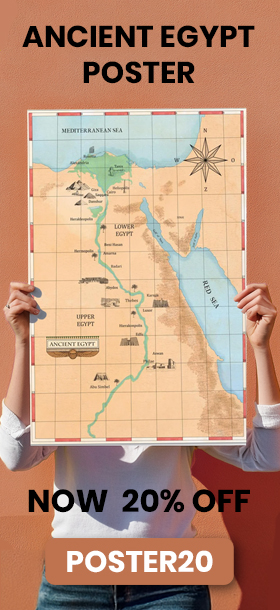The Ancient Egyptian Pharaohs
Ancient Egyptian pharaohs were considered to be both divine deities as well as mortal rulers. Throughout the 30+ dynasties in ancient Egyptian history, it is speculated that some 170 or more rulers reigned over the great land of Egypt during a three thousand year time span. The throne of Egypt was primarily intended to be succeeded from father to son, however in many cases this line of kingship was interrupted by murder, mayhem and mysterious disappearances.
Pharaohs were the god kings of ancient Egypt who ruled between 3150 B.C. and 30 B.C. (when Rome conquered Egypt). Each time a new family took control of the throne, a new kingdom began in the history of this fascinating nation. While rulers often intermarried with daughters, granddaughters, sisters and brothers to keep the throne within the family the throne still managed to shift hands multiple times; creating a dynamic and complex pharonic history.

© Xuan Che - Pharaoh's Bust
Definition: the word pharaoh refers to the title of the ancient Egyptian kings. The title “pharaoh” means the “great house” and refers to the royal palace.
Thirty-one Dynasties ruled from the Early Dynastic Period to the Ptolemaic Period. Scholars also include a Dynasty 0 but any kings from this period are not well represented in the archaeological record. Some Dynasties ruled at the same time in different areas of Egypt during the intermediate periods.
10 Famous Pharaohs
Below is a top 10 of the most famous Egyptian pharaohs:
- Tutankhamun (aka King Tut) restored the capital to Thebes after the death of Akhenaten and restored the worship of the old gods. Later pharaoh's erased his name from some king lists so scholars found his tomb's goods intact in the 1920s.
- Cleopatra VII was the last pharaoh of Egypt who tried to hold off the Romans under Augustus. She ruled beside three pharaohs including her young son and was the lover of Marc Antony.
- Ramses II ruled during the New Kingdom for either 66 years. He built all over Egypt and many of his statues and temples are still standing today. He is probably the most prolific of the ancient Egyptian pharaohs, siring over 100 children with more than a dozen wives.
- Ramses III was the last king of the New Kingdom and is considered the last great pharaoh. He was murdered by one of his wives.
- Hatshepsut ruled during the New Kingdom for around 20 years. She organized military campaigns and sent out trade expeditions to bring exotic goods to Egypt.
- Akhenaten ruled during the New Kingdom for less than 20 years. Scholars call him the hieratic pharaoh because he forbade the worship of the old gods. He built Amarna as the center for the worship of his god, Aten.
- Khufu also known as Cheops, ruled during the Old Kingdom and built the Great Pyramid.
- Djoser ruled during the Old Kingdom and built the first true stone pyramid, the Step Pyramid.
- Thutmose III was the 6th pharaoh of the 18th dynasty. He ruled Egypt for 45 years and created the largest empire ever in Egypt. Thutmose was buried in the Valley of the Kings.
- Amenhotep III was the son of Thutmose IV and was the 9th pharaoh of the 18th dynasty. He ruled during the peak of ancient Egypt's power.
Click here for a list of the 25 most famous pharaohs of ancient Egypt
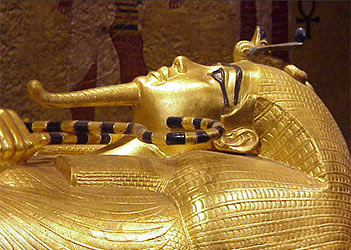
© Mary Harrsch - King Tut's Sarcophagus
Symbols of Kingship
Below is a list of some of the symbols used by the pharaoh to show his/her kingship. Images of the pharaoh show him/her wearing a crown or headdress with the uraeus (cobra) over the forehead. S/he also had a bull’s tail coming from his/her belt to show personal power and wore a false beard which was a sign of divinity.
- White Crown - the crown of Upper Egypt symbolized control over this region. The Pharaoh wore it on occasions that concerned only Upper Egypt. It resembles a tall white mitre or a white bowling pin without a bottom.
- Red Crown - the crown of Lower Egypt that symbolized control over this region. Pharaoh wore it on occasions that concerned only Lower Egypt. The bottom of this crown is circular with a tall thin part sticking up at the back and has a long curl attached to its base.
- Double Crown - the combined crown of Upper and Lower Egypt which symbolized the pharaoh’s control over them. This crown combined the Red and White Crowns, with the White Crown inside the Red Crown.
- Blue Crown - a headdress made of blue cloth or leather and decorated with discs of bronze or gold. Pharaoh wore it in battle and during some ceremonies.
- Atef Crown - a white crown decorated with ostrich feathers and topped by a small sun disc. Pharaoh wore it while performing religious rituals.
- Nemes Headdress - a blue and gold stripped head-cloth falling down both sides of the head, the front of each shoulder and the back. This headdress is part of some pharaoh’s death masks and sarcophagi (coffins) and King Tut wears it in his death mask.
- Crook - a blue and gold stripped staff with a hook on one end. Pharaoh holds it in statues and on sarcophagi, with the flail, crossed over his/her chest.
- Flail - came from a manual threshing device that had a long handle with a free-swinging stick that farmers used to beat wheat.
- Cartouche - loop of rope with a knot on one end that contained some of the pharaoh’s names in hieroglyphic inscriptions. It symbolized “that which the sun encircles” and meant that the pharaoh ruled everything the sun encircled. Discover more about cartouches...
- Serekh - written sign for kingship resembling a palace and containing one of the pharaoh’s names.
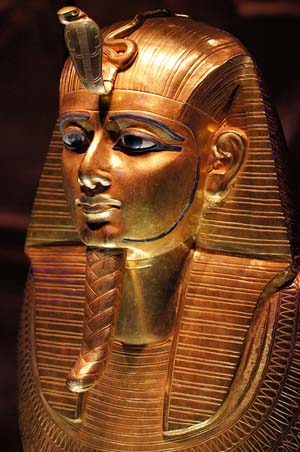
© Tjflex2 - The Golden Mask of Psusennes I
Life of the Pharaoh
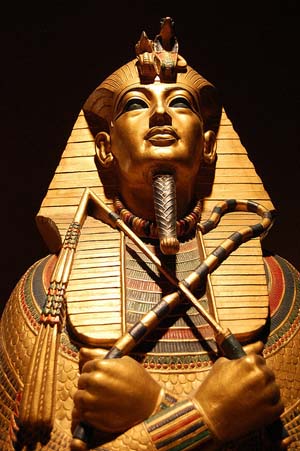
© Tiffany Silva - Sarcophagus of Tutankhamun
The crown prince began training to become the pharaoh as a young child through a series of lessons. Many of these lessons focused on building physical strength because the pharaoh often fought at the head of his army. Princes went to the royal stables where they learned how to ride and break wild horses. They also ran long foot races to build endurance and went on hunting and fishing expeditions.
Inheritance of the throne usually passed from a father to his eldest son but there were exceptions. Sometimes, a brother would become the next pharaoh after the previous king’s dead if there was no son to inherit. If the only heir was a woman, her husband could become the next pharaoh. Sometimes, a high official became pharaoh after the previous king's death. Some records state that some crown princes, who out lived their father, did not become pharaoh but the reason for this is not known.
Coronation
A new pharaoh always attended the burial of his/her predecessor and the coronation of a new pharaoh began on the first day of a new season. During many dynasties a new pharaoh's coronation began after the death of his/her predecessor. In some dynasties the old pharaoh presided over his/her successor’s coronation before his/her death.
The coronation was not a single event but a collection of ceremonies and festivals that could last an entire year. For this reason, the coronation year was not counted as part of the years a king reigned. The first year of a reign began after the coronation ended.

© doris_pemler - Baptism of the Pharaoh, part of the coronation rituals
List of Coronation Ceremonies and Festivals
Unification of Upper and Lower Egypt: a ceremony that was the symbolic reunification of the Two Lands of Egypt.
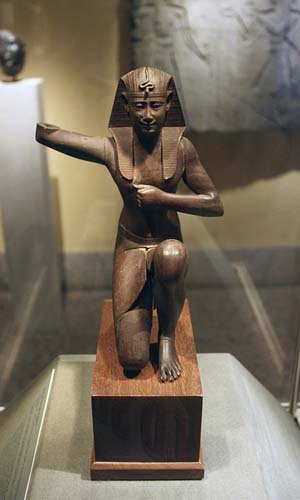
© Peter Roan - Ancient Egyptian Ritual Figure
Appearance of the king: a ceremony held after assuming the throne and repeated every two years thereafter. It had three steps:
- Pharaoh appeared wearing the White Crown as king of Upper Egypt.
- Pharaoh appeared wearing the Red Crown as king of Lower Egypt.
- Pharaoh appeared wearing the Double Crown as king of Upper and Lower Egypt.
Sed Festival: meant to restore the pharaoh’s vital life force but the details of its events are not well documented. It was first held during the coronation and the pharaoh repeated it during the thirtieth year of his/her reign. After this point, the pharaoh held it every three years but some preformed it more often.
Sokar Festival: a celebration involving the construction of a sacred boat that the pharaoh pulled to the Nile or a sacred lake. After its celebration during the coronation year, this festival took place every six years. Sokar was a god of the underworld and a guardian of royal cemeteries.
Names and Duties of Pharaoh
After becoming pharaoh, the king received four new names besides his/her birth name. The first name was the Horus name which scribes wrote inside a serekh. The Nebty name showed the pharaoh had the protection of the patron goddesses of the Two Lands and the pharaoh’s rule of both lands. The Golden Horus name emphasized the pharaoh’s divinity.
Scribes wrote the final two names inside cartouches. The Prenomen was the pharaoh’s coronation name and the one people knew him/her by in antiquity. The Nomen was the pharaoh’s given name and it is the name scholars use today with a numeral added if necessary.
As an example, here are the five names of Ramesses II:
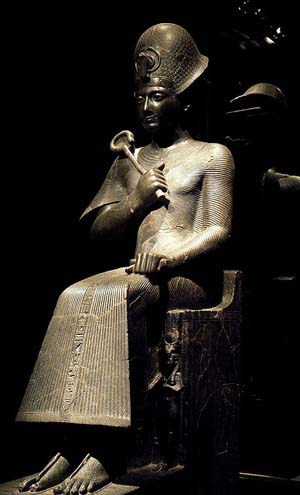
© Roberto Venturini - Ramses II statue
- Horus name: Kanakht Merymaat
- Nebty name: Mekkemetwafkhasut
- Golden Horus name: Userrenput-aanekktu
- Prenomen: Usermaatre-Setepenre
- Nomen: Ramesses (meryamun)
As king, the pharaoh had many duties that were civic and religious. The people saw him/her as the living Horus and the son of Ra. They believed only pharaoh could sacrifice to the gods but this belief lessened over time. Only the pharaoh could appoint the priests to serve the gods in his/her place. The people believed that s/he became Osiris after death and would continue to help his/her people in the afterlife.
Pharaoh was the commander-in-chief of the army and the highest judge in the land. The people saw the pharaoh as essential for keeping their lives in balance and keeping harmony in Egypt. As the living embodiment of Ma’at, the pharaoh ensured that order and justice existed in Egypt.
Burial of Pharaoh
Mummification and burial held an important place in Egyptian life. The Egyptians believed the body's preservation guaranteed the soul’s survival in the afterlife. The pharaoh began building his/her tomb soon after assuming the throne. The locations and types of tombs built changed over time and when the country’s capital moved. Tombs contained decorations of the pharaoh’s journey in the afterlife and texts from the Book of the Dead.

© Mary Harrsch - Decorated Sarcophagus
The earliest pharaonic tombs are the mastaba tombs made of mud-brick. Scholars found these tombs in some of the oldest cemeteries near the ancient capitals (see capital list below). Mastabas, like all ancient Egyptian cemeteries, were on the Nile’s west bank, which was the realm of the dead.
Pyramids were elaborations of the mastaba design made of stone. The first was the Step Pyramid of Djoser which Imhotep designed. Architects planned the pyramids and included a mortuary temple and other royal tombs in the complex. The Great Pyramid of Khufu at Giza is the greatest example of this type of tomb.
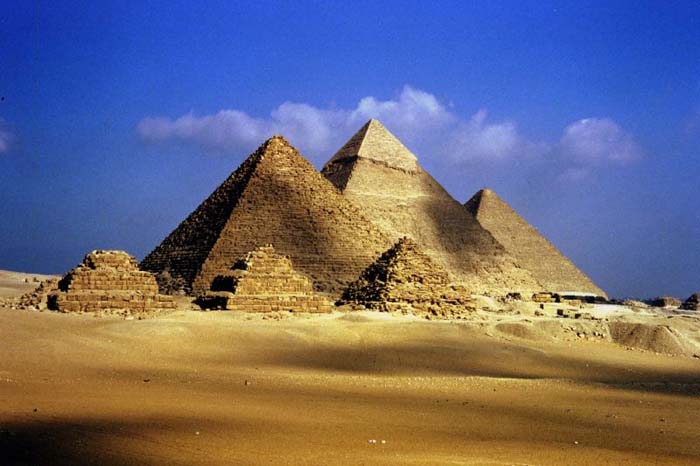
© DragonWoman - Pyramid Complex at Giza
Later pharaohs saw that grave-robbers broke into the earlier tombs so they made secret rock-cut tombs. The area where they built these tombs is now called the Valley of the Kings. Some tombs contained several chambers and more than one ruler.
Pharaohs received elaborate burials containing a wide variety of goods. At first, priests buried pharaohs with items like clothes, furniture, games and jewelry. During the Nineteenth Dynasty, priests began burying them with items made for the afterlife. An example of this are the clay shabti figurines made to serve the pharaoh. Priests placed food, oil and dishes in the tombs to nourish the king in the afterlife.
Five Important Capitals
- Memphis - the capital of Egypt during the Old Kingdom built at the mouth of the Nile Delta. This city was an important trade center and the pyramids of Giza are part of its necropolis (city of the dead).
- Thebes- the capital of Egypt during the Middle and New Kingdoms and the location of the religious centers of Luxor and Karnak. The Theban Necropolis includes a series of mortuary temples and the Valleys of the Kings and Queens.
- Alexandria - the capital of Egypt during the Ptolemaic period that Alexander the Great founded. Its rulers built the Great Lighthouse at Pharos and the Great Library.
- Akhetaten (Amarna)- the capital of Egypt during the reign of Akhenaten and abandoned after his death.
- Pi-Ramesses - the capital of Egypt built by Ramesses II in the far north that held 300,000 people and covered 6.9 square miles. After the Nile branch it was on silted up and the Nile formed a new branch, the people abandoned this city.
Quick Facts and FAQ
- Pharaohs were the god kings of ancient Egypt.
- Who was the first pharaoh of Egypt? Narmer or Menes was the first pharaoh of Egypt.
- The people believed the pharaoh’s existence was vital for a happy health.
- What pharaoh ruled the longest? Pepi II ruled Egypt the longest for about 90 years!
- At first, only pharaohs or their representatives could make sacrifices.
- Who was the most famous pharaoh? Tutankhamun is the most famous pharaoh today but Ramesses II was more famous in ancient times.

